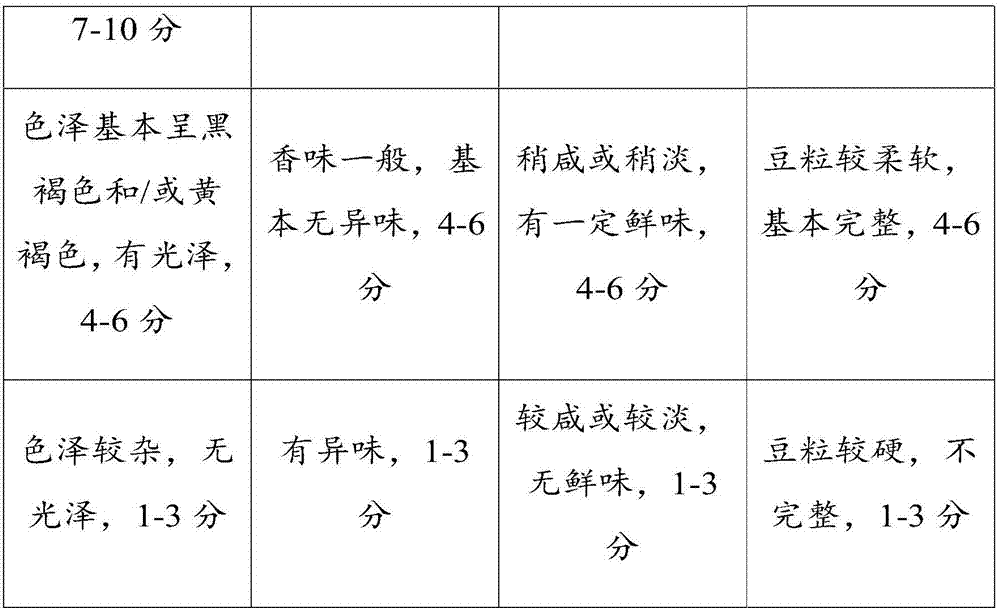Fermented soya beans and processing method thereof
A processing method and technology of fermented soy bean, which is applied in the field of fermented soy bean and its processing, can solve problems such as adverse effects on human health, high nitrite content, consumption amount and development prospect limit, etc., so as to reduce the probability of spoilage, strong inhibitory effect, The effect of strong anti-corrosion effect
- Summary
- Abstract
- Description
- Claims
- Application Information
AI Technical Summary
Problems solved by technology
Method used
Image
Examples
Embodiment 1
[0041] Select black beans that are free from insect damage, mildew, and deterioration as raw materials. After washing, the mixture of water and honey is soaked at 30°C for 40 minutes at 250mL:100g, so that the volume ratio of black beans after soaking to before soaking is 1.15:1.
[0042] Mix the soaked black beans with papain at a weight ratio of 80:0.5, and heat for the first 40 minutes at 50°C, and then heat for the second time at 80°C for 150 minutes.
[0043] The black beans after the second heating are squashed, then mixed with Aspergillus oryzae at a weight ratio of 1:0.08 and fermented for the first time. The number of spores of Aspergillus oryzae mixed in each gram of squashed black beans is 2×10 6 One. The first turning of koji started at 20h of the first fermentation and lasted for 1min, and then the second turning of koji was started at 28h of the first fermentation, lasting 3min, until the first fermentation was 38h, and the bean koji was obtained.
[0044] The soybean k...
Embodiment 2
[0046] Select soybeans that are free from insect damage, mildew, and deterioration as raw materials. After cleaning, the mixture of water and honey is soaked in 300mL:200g at 40°C for 30 minutes, so that the volume ratio of soybeans after soaking to before soaking is 1.3:1.
[0047] Mix the soaked soybeans with papain at a weight ratio of 120:1, and heat for the first time at 55°C for 30 minutes, and then at 100°C for the second time for 80 minutes.
[0048] The soybeans after the second heating are squashed, and then mixed with the mixed strains of Aspergillus oryzae, Mucor racemosa and Rhizopus nigricans at a weight ratio of 1:0.2 and the first fermentation is mixed with each gram of squashed soybeans The number of spores of the mixed strain is 4×10 6 One. The first turning of koji was started at 22h of the first fermentation and lasted for 2min, and then the second turning of koji was started at 30h of the first fermentation, and lasted 4min, until the first fermentation was 38h...
Embodiment 3
[0051] Select soybeans and black beans that are free from insect damage, mildew, and deterioration as raw materials. After cleaning, soak a mixture of water and honey at 275mL: 150g at 35°C for 35 minutes to make the volume of the soybeans and black beans after soaking and before soaking. The ratio is 1.225:1.
[0052] The mixture of soaked soybeans and black beans was mixed with papain at a weight ratio of 100:0.75, and heated at 52.5°C for the first 35 minutes, and then at 90°C for the second time for 115 minutes.
[0053] The mixture of soybeans and black soybeans after the second heating is squashed, and then mixed with the mixed strains of Aspergillus oryzae, Aspergillus niger, Mucor Gouda and Rhizopus chinensis at a weight ratio of 1:0.104 and the first fermentation is carried out, squeezed per gram The number of spores of the mixed strain in the mixture of soybeans and black beans is 3×10 6 One. The first turning of koji was started at 24h of the first fermentation and last...
PUM
 Login to View More
Login to View More Abstract
Description
Claims
Application Information
 Login to View More
Login to View More - R&D Engineer
- R&D Manager
- IP Professional
- Industry Leading Data Capabilities
- Powerful AI technology
- Patent DNA Extraction
Browse by: Latest US Patents, China's latest patents, Technical Efficacy Thesaurus, Application Domain, Technology Topic, Popular Technical Reports.
© 2024 PatSnap. All rights reserved.Legal|Privacy policy|Modern Slavery Act Transparency Statement|Sitemap|About US| Contact US: help@patsnap.com









